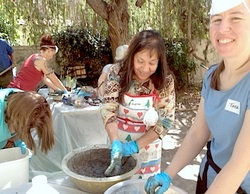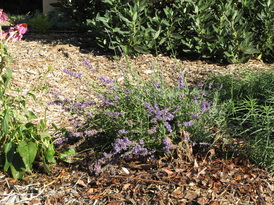August has been a month of surprises.
We were excited that our plants were producing so much, and were laden with nearly ripe fruit. We were truly baffled when, expecting huge harvests of apples, cucumbers, and tomatoes, we arrived at the garden to find our plants stripped bare. Could it be animal marauders? Some mysterious wasting? Or human scavengers who cleaned us out?
We investigated the clues. We quickly ruled out animals, as there was no scat, footprints, or breakage of limbs or vines associated with animal pillage. We saw no signs of wasting or dropped fruit. We decided that humans had perpetrated the harvest, as our outside buckets disappeared along with the produce.
This precipitated a long conversation about the nature of the garden. Some were outraged that someone would take everything. Others were fine with it, as long as the people were hungry and would use the food. Still others were anxious to ensure that produce would be shared in the future.
This precipitated a long conversation about the nature of the garden. Some were outraged that someone would take everything. Others were fine with it, as long as the people were hungry and would use the food. Still others were anxious to ensure that produce would be shared in the future.
The reality is that the Throop Learning Garden is an urban garden situated at a busy intersection with an active bus stop. We assumed from the beginning that people from the street would pick the produce from the garden. In fact, we encouraged the neighbors to come and pick. What took us by surprise was the absolute stripping of the harvest, so that nothing was left for us or others. But does this mean our labors have been for naught? Or is this a sign of success, that food is going to the hungry who need it? We may never know for sure. But our work continues, as does the conversation.
We investigated the clues. We quickly ruled out animals, as there was no scat, footprints, or breakage of limbs or vines associated with animal pillage. We saw no signs of wasting or dropped fruit. We decided that humans had perpetrated the harvest, as our outside buckets disappeared along with the produce.
This precipitated a long conversation about the nature of the garden. Some were outraged that someone would take everything. Others were fine with it, as long as the people were hungry and would use the food. Still others were anxious to ensure that produce would be shared in the future.
This precipitated a long conversation about the nature of the garden. Some were outraged that someone would take everything. Others were fine with it, as long as the people were hungry and would use the food. Still others were anxious to ensure that produce would be shared in the future.
The reality is that the Throop Learning Garden is an urban garden situated at a busy intersection with an active bus stop. We assumed from the beginning that people from the street would pick the produce from the garden. In fact, we encouraged the neighbors to come and pick. What took us by surprise was the absolute stripping of the harvest, so that nothing was left for us or others. But does this mean our labors have been for naught? Or is this a sign of success, that food is going to the hungry who need it? We may never know for sure. But our work continues, as does the conversation.

Since then, a sign has been posted, asking that people pick only a little, leaving food for others. So far, it seems to be working.
The other big surprise was the utter delight we shared at the August 24th Hypertufa Workshop with Jim Bledsoe. We enjoyed a good turnout.
Jim gave a great presentation about working with hypertufa. We explored mixtures and different types of molding techniques. All the participants went home with several portable projects, besides experiencing the construction of two large earth molded projects. We ended with a shared potluck lunch that allowed everybody a chance for conversation and to get to know each other better.
— January Nordman
The other big surprise was the utter delight we shared at the August 24th Hypertufa Workshop with Jim Bledsoe. We enjoyed a good turnout.
Jim gave a great presentation about working with hypertufa. We explored mixtures and different types of molding techniques. All the participants went home with several portable projects, besides experiencing the construction of two large earth molded projects. We ended with a shared potluck lunch that allowed everybody a chance for conversation and to get to know each other better.
— January Nordman





